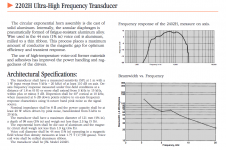So I have these two JBL 075 Ring Radiator bullet tweeters. At around 106dB/W/m It would take a lot of padding down to mate with normal speakers. So what to do. one could
1. By some really expensive compression driver based mid horns
2. Get a pair of 8 or 10 inch PA midranges per side (or a big line array of 4")
3. Some sort of front loaded horn based on full ranges I have laying around
4. Dive into unity horns using 4" or 6x9" drivers I have on hand.
So 3 and 4 are the most appealing. Can the 075s work firing into the end of a unity horn instead of a compression driver? Anyone ever use 6x9 in either front loaded MR horn or unity horn?
I would be expecting the midranges to cover about 500-5k.
1. By some really expensive compression driver based mid horns
2. Get a pair of 8 or 10 inch PA midranges per side (or a big line array of 4")
3. Some sort of front loaded horn based on full ranges I have laying around
4. Dive into unity horns using 4" or 6x9" drivers I have on hand.
So 3 and 4 are the most appealing. Can the 075s work firing into the end of a unity horn instead of a compression driver? Anyone ever use 6x9 in either front loaded MR horn or unity horn?
I would be expecting the midranges to cover about 500-5k.
I suspect that using them in such a way is an ambitious task to put it lightly, some would suggest impossible. The main issue is that midranges in unity horns rarely cover higher than 2khz or so due to the physical difficulties of placing a port within a few cm of the tweeter aperture. However I'd love to be proven wrong, and certainly using a conventional tweeter at the apex of the horn has been done before, but at an xo of 5khz? Maybe not
Pad them down and use with whatever you'd like. I've got multiple pairs of 075 and 2402H, cross around 2kHz and enjoy. They were my gateway to horns.
That seems to be what my research is showing. Normal front loaded horn seems more doable. Would trial horns made out of foam board be of any use or does the material need to be sturdier to have any real meaning? The scuttle but that I have heard is that these older 075s are pretty ratty below 5K. Kevin, I take it your experience has been more positive in that frequency range.
Power handling is somewhat limited at 2kHz, but I have a really early pair of 075 with the original diaphragms and they're very, very nice. They have this sort of ethereal, airy, but detailed quality. The 2402 either H or J is also nice. Diaphragms are the thing though, later ones seem not as good. You've sort of inspired me to consider using them in a small system in my home office with a pair of 8 inch woofers. I need a speaker upgrade in that space.
FWIW, virtually all my large speaker/horn test rigs [including a full size Jensen 35 Hz BLH] were made from heavy duty motorcycle shipping 'crates' lifted from the nearby local Honda Dealer's trash bin and plenty of 3M industrial packing tape, scrap wood for bracing/splicing.
I've made small stuff including > 1200 Hz HF piezo horns with architectural foam core board, but thinking it will need throat, mouth reinforcement for mids.
I've made small stuff including > 1200 Hz HF piezo horns with architectural foam core board, but thinking it will need throat, mouth reinforcement for mids.
1) An 075 or 2402 could work firing into the end of a unity horn, but it's own small exponential horn will determine it's directional pattern, which drops from 60 degrees at 4-5kHz to 40 degrees at 10kHz.1)Can the 075s work firing into the end of a unity horn instead of a compression driver?
2)Anyone ever use 6x9 in either front loaded MR horn or unity horn?
I would be expecting the midranges to cover about 500-5k.
A "Unity" type horn uses a conical expansion, the initial side wall angles determine the nominal dispersion pattern.
2) Multiple entry horns (MEH) like the Unity style use small ports in front of the mid/bass drivers to enter the horn. The enclosed volume between the cone and port creates an acoustic bandpass low pass filter, which (after an upper peak) steeply cuts the upper response of the driver.
To increase the upper bandwidth requires minimizing the enclosed volume, more difficult to achieve with a 6"x 9" than a standard cone driver.
Using a 4" with a cone filler plug with minimal volume left, the filler within a few mm of the cone, I doubt usable response would extend past 2.5kHz, while the 075 response drops steeply below about 3.15kHz, leaving a dip and ragged response in the critical 2.5kHz range.
Using your present drivers in a vertical array with the 075 centered or MTM would probably give you better results with far less effort, and if you plan to use passive crossover components, far fewer parts.
Art
Attachments
- Home
- Loudspeakers
- Multi-Way
- JBL 075s Cone midrange horn, unity horn,???
